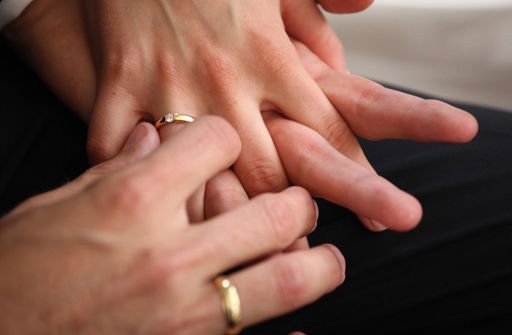When will you marry? Age of marriage in Germany
- 13. August 2017 - Family, Genealogy, General, Germany, Hamburg, Knowledge
Many people probably know the question, when they will (finally) marry, all too well. At least it isn’t much of a problem in the western world to live together and have children without being married. In the past it would have been a scandal. But at what age did people marry? And is it true that it happened much earlier than today?
These questions are relevant for genealogy as well. To find ancestors or specific marriage or birth dates it may well be relevant to have an idea how big generations spans may have been or which age of marriage might be probable.
The average age of marriage
In fact people didn’t marry much younger than today. You can see this quite clearly, if you look at the average age of marriage. In 2015 men in Germany married with 33.8 years, women with 31.2 years. Compared to other countries this is relatively late.
It is true that the average age of marriage is rising over the last years. In 1991 it was 28.5 years for German men and 26.1 years for women. That is actually quite a lot. But if you look at the age of marriage in Prussia for example in the year 1900, it was 28.9 years for men and 26.2 years for women. There is not a huge difference to 1991. If you look even farther, for instance at the year 1867 the average age of marriage was 30 or rather 27.4 years in Prussia. In the first half of the 19th century it was as well about 28 years for men and 26 years for women. And even in the middle ages people didn’t necessarily marry earlier.
After World War II however, between 1950 and 1970, the average of marriage dropped. The lowest average age was apparently in 1970 with 25.3 years for men and 22.6 years for women.
Marriageability
Different to the average age of marriage is the legal framework. Today in Germany you are able to marry as soon as you are of age. This means, basically every German that is at least 18 years old can marry. From 16 onwards a marriage is possible under certain conditions, if the parents or a court agree.
In the past different and often double standards applied. This means, the sexes were treated differently. Often, sexual maturity was a criterion for the determination, but for men, economic aspects and the completion of military duties were important as well. This is why the minimum age for men often was higher than for women. The temporal as well as regional differences were diverse. Therefore only few examples for minimum marriage ages can be mentioned.
In the middle ages, girls were allowed to be married at around 12 or 13 years, boys from 14 onwards. Sometimes even earlier. Betrothals were possible with only 7 years according to church law. Especially in the nobility we know about weddings and betrothals in history of very young children for political objectives. Such very early marriages weren’t the norm within the normal population though.
In 1875, the law of the German Empire on the certification of the civil status and marriage took effect. According to this, women were allowed to marry from 16 years onwards, men from 20 years onwards. However, earlier marriages were possible by dispensation (exemption).
Impediments to marriage and marriage bans
Why didn’t people marry earlier? As today, it was important that an adequate livelihood for a new family could be provided. Many probably waited more or less voluntarily until they were able to ensure it. But one of the reasons for the high age of marriage probably were the different impediments to marriages and marriage bans that applied in the German states as well.
Often, marriage permissions of the respectively responsible authorities were required. In the middle ages, people who wanted to marry often needed the consent of their landowner. In Hamburg, it was necessary to have the rights of citizenship to get a marriage permission from the middle of the 18th century onwards. To acquire them, you had to pay a fee, had to earn an income that you could live on and you had citizen’s militia duties including the purchase of a uniform as well as weaponry. Not everybody who wanted to marry could afford this. For relocated persons the terms were even harder. Furthermore, many inhabitants weren’t allowed to marry in any case. For example, ordinary soldiers, journeymen (who were only allowed to marry after they acquired the title of master craftsmen) as well as craftsmen that didn’t belong to the guild. But for instance in Southern Germany, the chances of marriage of poor social classes were restricted from the end of the 18th century well into the 19th century as well. On the record this was usually to lower poverty and to unburden funds for poor relieve. In fact, these policies didn’t result in a decrease of poverty, but rather strengthened the differences between classes and favored the development of so called concubinages as well as illegitimate births. Sometimes, marriages were achieved later on, but not always. It were probably especially the church as well as higher classes that deemed these domestic partnerships “immoral”. Within their own milieus, it can be assumed that there often was some kind of acceptance. But there was the thread of being prosecuted by the police and possibly being forced into separation.
By contrast, illegitimate relationships as well as children were a scandal in bourgeoisie as well as nobility. But bourgeois men often married late as well. Especially the educated middle-classes had long periods of education and therefore it needed quite some time for a man to be able to provide for a family. Often, relatively old men married significantly younger women. This wasn’t usual in marriages of workers and lower classes though.
And what does this mean for genealogy?
At Beyond History, we surmise an age of marriage from 23-25 years onwards for both sexes when we are researching ancestors. If you are looking for children you can look 1-2 years before the date of marriage as well. As we described before, it happened that people married only after the birth of one or even more children.


0 comments